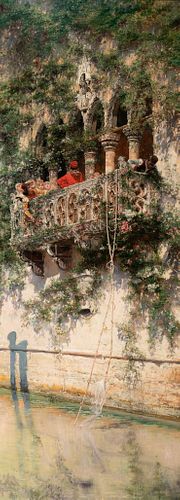JOSE VILLEGAS CORDERO (Seville, 1848 - Madrid, 1921). "Party in the Venice canal". Oil on canvas.
Lot 85
About Seller
Setdart Auction House
Carrer Aragó 346
Barcelona
Spain
Setdart Subastas was born in 2004 and is currently the first online art auction in Spain with solidity, prestige and reliability guaranteed by our more than 60,000 users. Setdart has a young, dynamic and enterprising team ready to successfully manage the purchase and sale of art works through custom...Read more
Estimate:
EUR€60,000 - EUR€70,000
$62,500 - $72,916.67
Absentee vs Live bid
Two ways to bid:
- Leave a max absentee bid and the platform will bid on your behalf up to your maximum bid during the live auction.
- Bid live during the auction and your bids will be submitted real-time to the auctioneer.
Bid Increments
| Price | Bid Increment |
|---|---|
| EUR€0 | EUR€10 |
| EUR€200 | EUR€25 |
| EUR€500 | EUR€50 |
| EUR€1,000 | EUR€100 |
| EUR€3,000 | EUR€200 |
| EUR€5,000 | EUR€500 |
| EUR€10,000 | EUR€1,000 |
| EUR€20,000 | EUR€2,000 |
| EUR€50,000 | EUR€5,000 |
About Auction
By Setdart Auction House
Nov 10, 2021
Set Reminder
2021-11-10 08:00:00
2021-11-10 08:00:00
America/New_York
Bidsquare
Bidsquare : 19th & 20th Century paintings and Decorative Arts
https://www.bidsquare.com/auctions/setdart-auction-house/19th-20th-century-paintings-and-decorative-arts-7800
Setdart Auction House sofia@setdart.com
Setdart Auction House sofia@setdart.com
- Lot Description
JOSE VILLEGAS CORDERO (Seville, 1848 - Madrid, 1921). "Party in the Venice canal". Oil on canvas. Presents label of M. Newman Ltd (Fine art dealers). It has a period frame. Signed and located (Venice) in the lower right area. Measurements: 153 x 58 cm; 167 x 73 cm (frame). At the end of the seventies and during the eighties, José Villegas worked intensively in the city of Venice. Vitally he was in one of the best moments of his career, acclaimed by critics and the public, being recognized as a worthy heir of Fortuny, Villegas based his work on historical themes, introducing an aesthetic of Renaissance influence, as seen in his work "El Triunfo de la Dogaresa", 1888 where the figures have certain similarities with those of this work. The present painting shows a furtive view of the canal and a balcony in Venice, a theme that faithfully reflects that moment of consolidation of the artist's career. The perspective with which the scene is conceived, the vaporousness and at the same time precision of the chromatic range, and the technical quality that is appreciated in the diverse elements that compose the scene as for example; the characters, the architecture, or the water...etc, denote the maturity of the artist. José Villegas began his apprenticeship with José MarÃa Romero, under whose guidance he studied for two years. He then entered the School of Fine Arts, where he was a disciple of Eduardo Cano. At an early age he took his painting "Pequeña filósofa" to the Sevillian Exposition of 1860, which was sold for 2,000 reales. Around 1867, still in his formative years, he painted two canvases: "Niñas pidiendo limosna", highly praised by the critics, and "Colón en la Rábida", acquired by the Dukes of Montpensier. He then traveled to Madrid, where he went to the studio of Federico de Madrazo. There he befriended Rosales and Fortuny, and studied the masters of the Prado Museum. During this period he copied Velázquez, whose spontaneous style he adopted for his pictorial technique, as well as his vibrant color. Seduced by the orientalist work of Fortuny, Villegas returned to Seville and visited Morocco, from where he brought back some paintings and sketches. At the end of 1868 he decided to move to Rome in the company of Rafael Peralta and Luis Jiménez Aranda. There he attended night classes at the Chigi Academy and shared his studio with other colleagues, until he moved to Rosales' workshop. His work, at this time, focused on costumbrista themes, a genre in which Villegas achieved resounding success, being in constant demand by a clientele eager for traditional themes, especially bullfighters and dancers. His extraordinary versatility also allowed him to satisfy the demand of an international clientele that, after Fortuny, demanded Arab fantasy themes. Thus, Villegas took advantage of his sketches taken in Morocco, without forgetting the themes of genre and "casacones". In the mid-seventies he returned to Seville and visited Morocco again. Back in Rome from 1876, he picks up the torch bequeathed by Fortuny and becomes the most admired and quoted painter among dealers and collectors. He continued to work on his orientalist and costumbrist themes, and sent his works to Spanish exhibitions. In 1878, following a commission from the Spanish Senate, Villegas began to work on history themes. Also, in the mid-eighties he focused on paintings directly inspired by Italian Renaissance art, his culminating work in this style being "The Triumph of the Dogaressa", painted in 1892 and exhibited with great success in Berlin. During these years he worked especially in Venice, a city that offered him an inexhaustible framework for the setting of his compositions. In 1898 he was appointed director of the Academy of Fine Arts in Rome, in 1901 director of the Prado Museum and in 1903 academician of San Fernando.
- Shipping Info
-
In-house shipping available. Please inquire at admin@setdart.com.
-
- Buyer's Premium



 EUR
EUR CAD
CAD AUD
AUD GBP
GBP MXN
MXN HKD
HKD CNY
CNY MYR
MYR SEK
SEK SGD
SGD CHF
CHF THB
THB

















